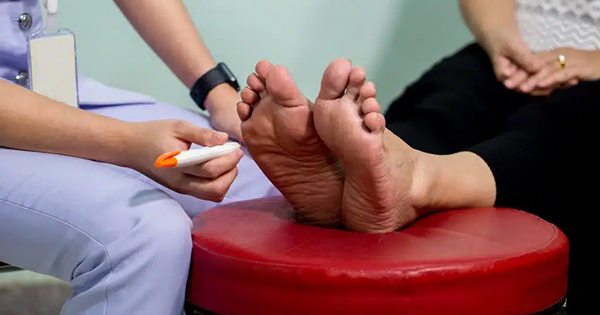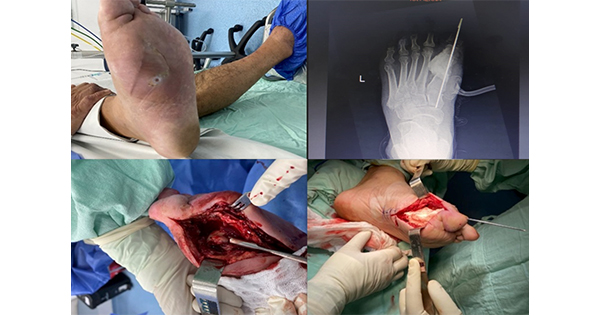Diabetic foot ulceration is one of the most common and devastating complications of diabetes mellitus, and the most common cause of non-traumatic lower limb amputation in the Western world.
The impact of foot ulceration is both personal and financial. Approximately 6% of the US diabetic population of 14 million undergo lower limb amputation (Kaufman and Bowsher, 1994); the estimated cost in 1998 was £500 million (Bild et al, 1989). These stark statistics emphasise the importance of both the prevention and correct management of foot ulceration.
Doppler ultrasound
In 1842 Christian Doppler published his paper on the effects of movement on emitted or reflected wave-form energy, stating that the frequency of the wave form varied according to the velocity of the object (Doppler, 1842).
This so-called ‘Doppler effect’ holds true when either the transmitter or the detector is moving relative to the other, and applies to all forms of wave-form energy, including sound and ultrasound. The Doppler effect accounts, for example, for the varying noise of a siren as the vehicle moves towards or away from an observer.
Ultrasound (i.e. sound above 20KHz) has the ability to penetrate tissues, the depth of penetration being related to the frequency. Most hand-held Doppler probes have a frequency between 2 and 10MHz, with probes used to detect peripheral arterial and venous flow usually being of 5 or 8 MHz.
Ultrasound is reflected from all tissue interfaces and this reflected sound forms the basis of modern ultrasound examination. When ultrasound encounters a moving object such as a red blood cell, the reflected wave undergoes a frequency shift, the extent of the shift depending on the speed and direction of the blood flow. By combining the use of Doppler and a blood pressure cuff to control flow, systolic pressure can be measured.
The principle of the Doppler effect was first applied to medicine in 1957, in a study on the structure and function of the heart (Yao, 1970). In 1959 a study of peripheral arteries was published (Satomura, 1959). Satomura and Kaneko later described the use of this technique to examine instantaneous changes in blood flow in peripheral arteries (Yao, 1970).
Ankle pressure and the pressure index
In 1961, Franklin et al produced an ultrasound flow meter based on the Doppler effect, from which the modern portable continuous-wave Doppler was developed. They successfully used this equipment in patients with peripheral venous arterial disease, evaluating both the pulse wave form and the systolic blood pressure (Franklin et al, 1961).
Since this early work, of all the modalities used in vascular diagnosis, none has proved more useful, or been as widely used, than Doppler ultrasound. The hand-held Doppler probe is now widely used as a screening test to assess the peripheral arterial circulation, and can be used to derive an absolute pressure, a segmental pressure, a pressure index or a wave form for analysis (Vowden et al, 1996; Vowden, 1997).
The method employed for Doppler pressure measurement and ankle–brachial pressure index (ABPI) calculation is well established (Vowden et al, 1996). Provided that a standard protocol is followed by an experienced practitioner, ankle pressure measurements are remarkably free of error, absolute pressures rarely varying by more than 10mmHg.
Eliminating variations in central pressure, by converting ankle pressures to an index, produces even more consistent ABPI results. Variations in the ABPI of >0.15 usually imply significant pathological change (Sumner, 1989).
The test is, however, subject to inter- and intra-observer variations (Fowkes et al, 1988; Ray et al, 1994). In addition, resistance to arterial compression, such as occurs in the presence of medial arterial wall calcification – a particular problem detected in up to 30% of people with diabetes (MacKay et al, 1995) – can cause falsely high readings (Sumner, 1989; Hobbs et al, 1974).
Toe pressures
As vascular calcification rarely extends to the digital arteries, a more reliable measure of peripheral arterial disease in people with diabetes is the absolute toe pressure or the toe-brachial systolic pressure index.
Measurement of toe pressure is, however, more demanding and subject to significant positional and temperature variation (Carter, 1993). The size of digital cuff is also critical, pressure measurements being over-estimated with too small a cuff and underestimated with too wide a cuff. Between 2 and 3cm wide appears to be the best cuff size (Carter, 1993).
The hand-held Doppler can be used to measure digital pressures, but more reliable results are obtained using photo or strain gauge plethysmography (Sumner, 1993) or a pulse oximeter (Samuelsson et al, 1996).
Toe pressures are directly related to the likelihood of foot ulceration healing. An absolute pressure of 50mmHg is usually taken as the lower limit of normal (Carter, 1993). With absolute toe pressures above 55mmHg, 95% of diabetic foot ulcers healed, whereas with pressures of less than 30mmHg less than 45% healed. A similar relationship exists for ankle pressures (Takolander and Rauwerda, 1995).
When there is concern over the accuracy of the ankle pressure and equipment, or the necessary skills are not available to assess toe pressures, an alternative is to apply the pole test.
This test measures the effect of elevation of the leg on the ankle systolic pressure (Goss et al, 1991; Smith et al, 1994). Multiplying the height above the bed at which the signal disappears by 0.735 converts the height into a pressure in mmHg (Sumner, 1989).
Conclusion
Although peripheral neuro-pathy and extrinsic or intrinsic trauma are by far the most common cause of diabetic foot ulceration, it is frequently the unrecognised vasculopathy that prevents healing and increases the risk of amputation.
Only by careful assessment can those patients who may benefit from referral to a vascular surgeon be identified. Doppler testing should therefore form part of the basic examination of the ‘at risk’ or ulcerated foot.





